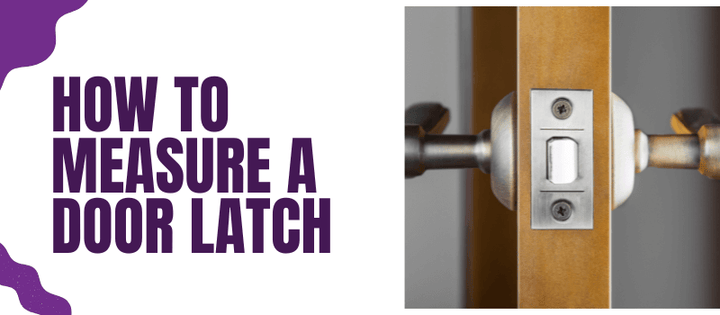
How to Measure a Door Latch
Do you have a creaky door latch that needs to be measured and replaced? An ill-fitted latch may cause the door to malfunction and not open or close properly. But before buying a new latch, you’ll need to know the right size and measurements of your existing latch.
In this article, we'll provide you information on how to measure a door latch correctly in order to find the best replacement for your needs.
Follow the below mentioned steps to measure a door latch using a tape measure.
-
Measure the Case Size

Usually, there is already a hole cut in the backplate and door jamb where the casing slides into, so make sure to measure the case depth of that hole for even more precision. Finally, jot down any other dimensions such as screw holes and corner radius.
-
Measure the Bracket Size
A backset is what holds the latch in place and thus influences the measurement of the entire latch. The bracket is usually located at the top or side of the lever handle of the door, so start by carefully looking around until you locate it.

How to Select Correct Door Latches
When selecting door latches, it’s important to consider both the desired aesthetic as well as their practicality. The level of security is an important factor, and there are lever handles, door handles, and deadbolts available in various materials that provide different levels of theft deterrence. Make sure that the latch you select is strong enough to protect against whatever level of intrusions you are expecting.
For bathrooms and bedrooms, deadbolts may be the ideal option. Consider additional features such as easy access for an elderly person who might have difficulty lining up a key in a lock. Also, certain materials may be heavier or longer than others, so make sure that you know the latch size and measurements of your doors beforehand.
What Sizes are Door Latches in the UK
Door latches in the UK come in a variety of sizes in both imperial and metric units. Typically, common sizes range from 2 inches to 6 inches - equivalent to 50mm to 152 mm respectively - but there are variations available outside of this size range. Additionally, you'll find that there are two distinct backset measurements depending on the style and function of the door knob on your latch - 45mm or 60mm.
Choosing the right latch bolt size is essential not only for optimal performance but also for making sure that it fits into the door and provides sufficient security. It is best practice to measure before purchasing one, to ensure you get the perfect latch case for your existing door.
Final Thoughts
Having good quality door latches in the home is not only important for safety and security, but also for convenience. You want to be sure that when you leave or enter your home, your door will remain locked and secure. The better the quality of the latch, the less likely it is for your door to get stuck or malfunction over time. You can purchase reliable and high-quality door latches, door knobs, door frame, interior and exterior doors, and other parts of door furniture and accessories online from Emerald Doors.
FAQs on Measuring Door Latches
-
Are door latches standard size?
The size of door latches varies depending on the make and model of the door. Internal doors are typically smaller than external doors and therefore require a different-sized latch. Generally speaking, most residential door latch sizes tend to adhere to a standard dimension designed for universal compatibility between manufacturers.
-
How do you measure a door latch backset?
To measure a door latch backset size, you will need to measure the distance from the edge of the door where the latch is installed and then to the central part of the doorknob. The backset measurement can be taken with a tape measure or callipers depending on your specific needs.
-
What size door latches are there?
Door latches come in different sizes, both in imperial and metric units. Typically latch sizes range from 2 inches to 6 inches - equivalent to 50mm to 152 mm respectively - however, there are variations available outside of this size range. Additionally, you'll find that there are two distinct backset measurements depending on the style and function of your latch - 45mm or 60mm.
-
Are there different types of door latches?
Yes, there are multiple types of door latches. Some of the most common include mortice latch, tubular latches, deadbolt latch, and multi-point locking systems. Each type has specific features and benefits that should be considered when selecting the best option for your door.